
|

|
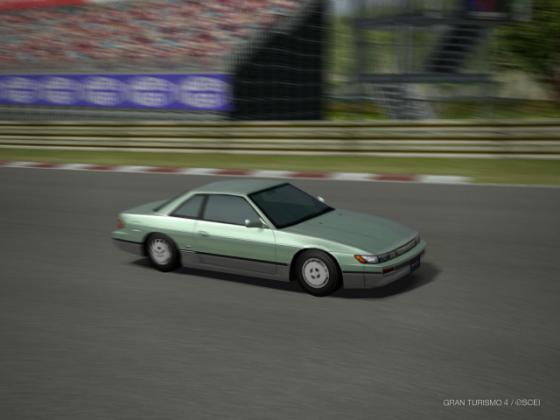
Years Represented: 1988-1991 ``````````````Type: Coupe
Games: GT1, GT2, GT3, GT4, GT5`````````````Country:
Japan
Price: $20,360 (GT3),
$5,673 ('91 GT4 Silvia Q's 2.0)
$6,600
('88 GT4 Silvia K's 1.8)
$7,932 ('88
GT5 Silvia Q's 1.8)
GT5 Silvia Q's Mileage: 61,276.2 (specs), 8,419 (tests)
Construction: unit
steel
Length: 176.0" // Width: 66.5" // Height: 50.8"
Wheelbase: 97.4"
Overhang: @ 6 feet 6.5 inches
Track: 57.7"
[F] 57.5" [R]
Ground Clearance: 5.3"
Weight: 2,446 pounds (Q's 2.0), 2,579 pounds (K's 2.0)
Steering: power-assisted rack & pinion
Layout: Front Engine/Rear Drive
Tires: 185/70R-14 (Q's}
205/60R-15 (K's)
F. Suspension: struts, coils, shox, anti-roll bar
R. Suspension: multilink, coils, shox, anti-roll
bar
Brakes: vented discs, solid discs
GT3 car probably had oil changed. Same goes for the GT4 car. The GT5 Q's
1.8 had 61k miles on it, and received oil change + engine rebuild
Engine: 1.8 or 2.0 liter DOHC
inline-4
Aspiration: natural or intercooled turbo
Fuel System: EFi
Valves / Cyl: 4
Bore x Stroke: 3.39
x 3.39"
Compression: 9.0:1 (natural), 8.5:1 (turbo)
GT3 Silvia K's
Final HP:
210 @ 6,000 rpm
Fnl Torque: 205 @ 4,000 rpm
Credits per HP: $96.95
Pounds per HP: 12.28
HP per Liter: 95.1
Redline: 7,000 // RPM Limit:
GT4 Silvia Q's 2.0
Final BHP: 138 @ 6,400 rpm
Fnl
Torque: 131 @ 4,800 rpm
Credits per BHP: $41.11
Pounds per BHP: 17.72
HP per Liter: 69.1
Idle: 1,000 // Redline: 7,500 // RPM Limit: 8,000
GT4 Silvia K's 1.8
Final BHP:
172 @ 6,400
Fnl Torque: 166 @ 4,000
Credits per BHP: $38.37
Pounds per BHP: 14.60
BHP per Liter: 95.0
Idle: 1,000 // Redline:
7,000 // RPM Limit: 7,500
GT5 Silvia Q's 1.8
Final BHP: 129 @ 6,400
Fnl Torque: 114 @ 5,200
Credits per BHP: 61.49
Pounds per BHP: 18.62
BHP per Liter: 71.3
Idle: 750 // Redline: 7,500 // RPM Limit: 8,000
GT5 test car did not have any maintenance.
Test car had 8,419 miles on it, and 133 hp, which is exactly what the dealer quotes, for once.
0-60
mph:
GT3 K's: 7.483 seconds
GT4 Q's 2.0: 9.433
GT4 K's 1.8: 7.866
GT4 Q's 1.8: 9.908
0-100 mph:
GT3 K's: 19.200 seconds
GT4 Q's 2.0: NA
GT4 K's 1.8: 19.683
GT5 Q's 1.8: 26.240
400 Meters
GT3 K's: 16.030 @ 91 mph
GT4 Q's 2.0: 17.258 @ 84 mph
GT4 K's 1.8: 16.120 @ 91 mph
GT5 Q's 1.8: 17.490 @ 83 mph
1 Kilometer
GT3 K's: 28.487 @ 119 mph
GT4 Q's 2.0: 31.087 @ 108 mph
GT4 K's 1.8: 28.832 @ 118 mph
GT5 K's 1.8: 31.409 @ 107 mph
100-zero mph:
3.67
3.77 seconds
4.10 seconds
5.417 "
test track lap:
2:29.521
2:49.508
2:41.777
1:07.xxx (GT5 Daytona Lap)
Top Gear RPM
@ 60 mph: 2,800 (Q's 2.0)
3,100 (K's 1.8)
Top Speed at Redline (GT3)
1st: 35.2 mph
2nd: 63.5 mph
3rd: 94.3 mph
4th: n/a
5th:
157.7 mph @ 6,850 rpm
Top Speed at Redline: GT4--Q's 2.0
1st: 38 mph
2nd: 68 mph
3rd:
99 mph
4th: 130 mph
5th: 139.80 mph @ 6,750 rpm
Top Speed at Redline: GT4--K's 1.8
1st:
32 mph
2nd: 58 mph
3rd: 87 mph
4th: 114 mph
5th: 144.71 mph @ 7,400 rpm
Top Speed at Redline: GT5--Q's 1.8
1st: 32.0 mph
2nd: 57.2
3rd: 86.8
4th:
119.0
5th: 136.0 mph @ 7,100 rpm
|

|

|

|

|
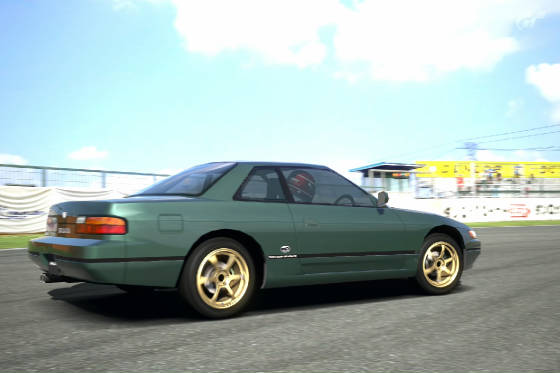
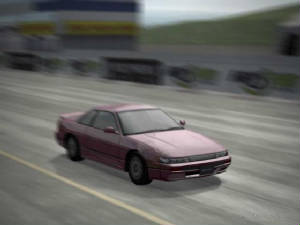
Year: 1988-1991 `````````````````````````````````Type: 2+2 Coupe
Country: Japan `````````````````````````````````````
Host: GT1 & GT2
---------------EXTERIOR--------------------
Nissan
may not have been trying to create a race car when developing early versions of the Silvia (which, incidentally traces its
lineage way back to the mid-60s) but this car is quite worthy of competition on a lower level and one of the easiest RWD cars
a beginner can race, unlike earlier versions of the Corolla and Celica. It is also one of the cheapest cars in town. On the
downside: don't expect to be winning many of the more advanced races. In my opinion this car is great for beginners and for
those who want to thrash a C class car around for the fun of it.
The Silvia is one of the quintessential cheap
cars to learn from if you want to race rear-wheel drive but aren't ready to handle something with loads of power. Incidentally,
a black Silvia Q was my first Gran Turismo car ever. I drove it around Autumn Ring Mini lap after lap, practicing for my very
first spot race, so the Q's will always be a special car for me.
GT1 and GT2 both feature the Sil80 as a prize from
the Front/Rear drivetrain races, which I'm not going into detail over (get it?) because the games already give us plenty of
info on this anomoly; but I will say that it's a great car and tends to handle the roads just the same as the regular
S13. In GT3, you simply win a normal Silvia K's 1800 from the FR Challenge, and there is no Sil80 in this game.
And
in GT4 or 5, all S13 generation cars lurk the used lots, and can usually be had immediately in 4, or after a few days in 5.
Silvias are popular. The Sil80 can be won after completing the Silvia Sisters manufacturer's races in GT4, and I'm not sure
what happens in 5, so far as prizes go. There is one final choice in GT5 the Silvia K's Dia selection, costing
22,390. This has to be a record: the highest-priced S13 ever! The reason it's so expensive, though, is because it's a Premium
model. I have yet to drive it at this writing.
GT2 also has the Daisun Silvia, a real-life GT300 racing machine...which
can be won in the Grand Touring Series race at Red Rock Speedway. Su-weet sweet car. I'm not sure if it can be found in any
other games, but the C-West Silvia (another GT300 auto) can be had in GT3, and I'm sure GT4 and 5 have some other goodies.
In
stock form, the Silvia Q's (1800 or 2000) is rather a boring, slow car, but is also great for a beginner
who's never driven a front engine/rear-drive before. This is one of the best FRs a beginner can touch, basically, and we'll
talk about why this is later on. So the car starts off slow, but after some inexpensive mods are applied it becomes a lot
more fun to drive. GT1, GT2, GT4, and GT5 have either 1.8 or a 2.0 liter S13s for sale, Q's or K's. But
in GT3, we can only find the K's version (both 1800 and 2000).
Usually, the Nissan dealership is packed with these cars in games that feature a used car lot (GT5
is the main exception), prices range from 4 to 8,000 cr. In GT3, the car is still affordable, but can't be called ‘cheap’
anymore since it's priced at $18,830--just above the starting money the game gives us. But then after GT3,
things change for the better. Apparently in GT4, they start having one of those tacky "EVERYTHING MUST GO" sales; prices takes
a huge nosedive...and now we're paying GT1 & GT2 prices again: somewhere around $5,000 is average.
My theory
is: as gamers and real-life amateur race drivers sought the Silvia, it became a bit of a collector's item. A car barely
noticed by the general public for awhile eventually became something to find; hence, the price went up. In GT3, the
reason we're paying so much more is perhaps the car in this game is supposed to be in absolute mint condition. The cars
in GT4 and 5, on the other hand have mileage. Even low-mileage cars in these games are nowhere near as expensive as the
K's in GT3.
In the GT1 Sunday Cup or RWD series, the computer tends to make the Silvia look bad (even the newer ones)
as they constantly are being portrayed as the losers of the pack. In reality, this car has an agility that makes up for its
slowness, and can be fun too. Those racing the Silvia K's in GT2, GT3, or GT4 will be able to take it further into the
game before needing to retire the car for something faster. But the good thing is, some enduros and intermediate races can
be accomplished in S13s, bringing us a profit margin that would make anyone smile.
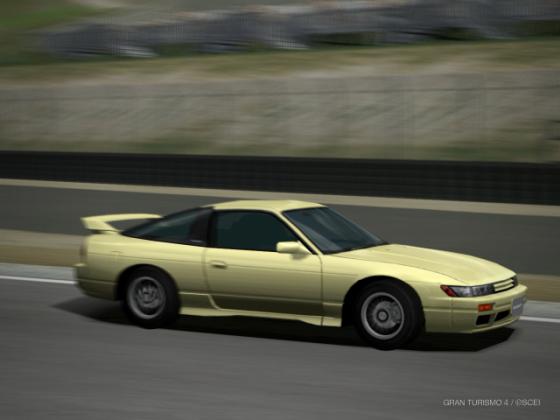
|
| A rare Sil80. It's half Silva/half 180SX (get it?) |
-------------ENGINE / DRIVETRAIN----------------
The Q's
is powered by a 1.8 or 2.0 liter DOHC 4-cylinder engine with natural aspiration, while the K's is higher-powered and turbo-charged.
The difference in engine size can be traced to year. Nissan introduced the S13 line with 1.8s in 1988, but upgraded to the
larger 2.0 in 1991. Hence, there's these two different years in every GT game except GT3. In any event, neither
unit is anything to fear at first.
Either car is perfectly tame with only stock parts installed, but both can be boosted up via turbo or
NA tuning (the GT3 K's only accepts turbos). Just enough power-ups can be had in any game to make things interesting.
Unfortunately, after-market suppliers only give us a stage 1 turbo for the Silvia Q's in GT1. This helps shave up to 3 seconds
off the car's 0 to 60 time, but it will still take awhile to get to the 150 mph top speed since horsepower drops off
once the car hits redline. Go with the Silvia K's if more speed is your desire. (like... duh)
The nicest thing about
these engines (especially the 2.0 turbo) are the way they pull. Torque isn't high, but the pistons dole out power very evenly
no matter when you step on the gas. The power band is broad, even for a 4-cylinder, rather than spikey. Whether you're at
4,000 rpms or 6,000, the engine will pull right up to its redline. This is true of naturally-aspirated or turbocharged
plants.
The gearing is completely adequate. You'll never need to buy the racing gearbox for this car unless you're desperately
trying to boost your top speed at the test track or something. Whether you're playing GT1, 2, 3, 4, or 5 you'll find
that either stock or close-ratio gearing are perfect for all the beginning and intermediate races. The spacing and speed of
all gears is even. Super-close gearing is not recommended unless you're rallying: too much shifting and not enough speed as
an end result, tho on certain tracks like Laguna Seca, I could see using it.
This is one of those autos in which
HP and torque both get lost, unfortunately, so shifting gears can typically occur at around 6,500 rpms unless one of the higher
turbos are being used, then you can probly let it redline.
--------------CHASSIS / HANDLING--------------
How can we sum this chapter up in a nutshell? Overall, handling rates good, especially while the car is tackling
Beginner to Intermediate events.
The Silvias in earlier games (GT1 and 2) will oversteer
and drift like more expensive, faster RWD cars, but their speed isn't high enough for this to become a seriously continuous
problem; it's more of a learning experience. Even the higher-powered K's version will take a lot of abuse before it can be
made to do anything so crazy as spin out on command.
Again, the suspension is very well-balanced and easy to dial-in
for any race. The S13 line was one of Nissan's first autos to feature their new multilink rear suspension, as well as an early
version of the HICAS self-steering rear wheels. Perhaps all this has something to do with why S13s are so easy to pilot in
comparison to some other Japanese rear-drives from the times. The Q's isn't fast enough to compete in higher-paced GT cup
races, so one can get away with just buying the sports or semi-racing set-up and be done with it for good. Stock parts
can be used in many games/situations as well.
Rally racing is the big exception, and might necessitate use of a full racing suspension. There are
some body roll, oversteer, and lateral movement issues on pavement, but all of these can be addressed in short notice.
Racing
tires are available, but you'll really only need them for the Silvia K's with a Stage 2 turbo in the earlier games, perhaps,
otherwise, stock or sport tires do just fine. It's just fun to race this car with the cheaper tires. In fact, one can
race this car in the Sunday Cup of any game (if you're good ) with stock tires and suspension,
(N tires in GT4) and blow away the competition.
It doesn't hurt that Silvias only weigh anywhere from 2,600 pounds
all the way down to 1,873 (GT1), and that they have a 53/47 weight distribution. Easy to work with. Even in GT4, these cars
display a minimum of understeer, feel planted and balanced most of the time, and have a predictable rear-end. Get power north
of about 220, and those rear tires' traction can easily be broken. It's unfortunate drifting is so difficult in GT4; otherwise
these would make perfect cars to drift. Front-end snapback has a tendency to ruin all this, unfortunately, unless the drifter
happens to be very experienced at avoiding it. In GT5 Silvias now handle the way they're supposed to, and drifting, or partial-drifting,
or anything in between, are now options.
Like other parts of the car, the brakes are adequate and well-balanced; though the back end will fishtail at high
speeds. You can get away with not buying a brake controller if you've got some experience. In GT2, 3, and 4, you'll need it
and perhaps a 1.5 limited-slip differential if you want to survive high-paced races. Once the pressure is on, the car still
handles well even on non-soft tires, but has a tendency to fishtail as mentioned before. This slippery behavior is fun....
Two
thumbs up (both of them mine) for this one.
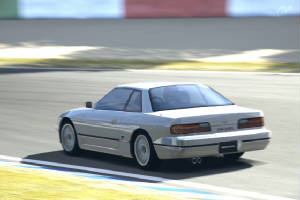
PROS
1). A relatively lightweight coupe, when compared to many others of modern times in our games.
2). Well-balanced body-work, handsome design. My opinion and many others.
3). A chassis that's easy
to work with. One of the best RWD cars a beginner can try; highly maneuverable. Experienced players may also delight
in tossing these cars about with minimal consequences.
4). A great car in horsepower-limited races.
5). K's cars get lots of turbo upgrades in GT3 &
GT4. All five turbo kits can be had in GT4, for instance, from Amuse or a few other tuning shops.
6). Inexpensive. Easy to modify immediately, even if you haven't started racing yet.
7). An overwhelming variety of used cars in different colors.
8). Street and sport tires will go a long way. Racing slicks can be delayed unless you've highly modified
the K car in GT1, GT2, or GT3. GT4 players should rarely find an excuse to ever equip anything grippier than S3s.
9).
Appropriate gearing for many tracks.
10). ADD: A Drifter's Delight!
11). GT1 & GT2: Racing kits for all!
12).
GT4: Fuel-efficient.
CONS
1). Too many of these in the dealership cuts back on memory for others missing from the game!
2). Silvia Q is under-powered. Can't be modified much. The K's has more go, but again it won't rule
all the roosts. That's where the Skyline comes in, I guess.
3). Lowish torque. Turbo lag also starts to step in with K's upgrades (depends
on the game, though).
4). The Silvia's great handling becomes iffy as power gets upgraded. In GT2 you will need superior parts
eventually to correct this.
5). In GT3, the Silvia can no longer be bought as a Day 1 Car. Booo!
6). Nissan had
a habit of making bland, inoffensive cars during the this era (late 80s/early 90s). The S13 is no exception.
Originally Published: May 24th, 2004
|

|

|

